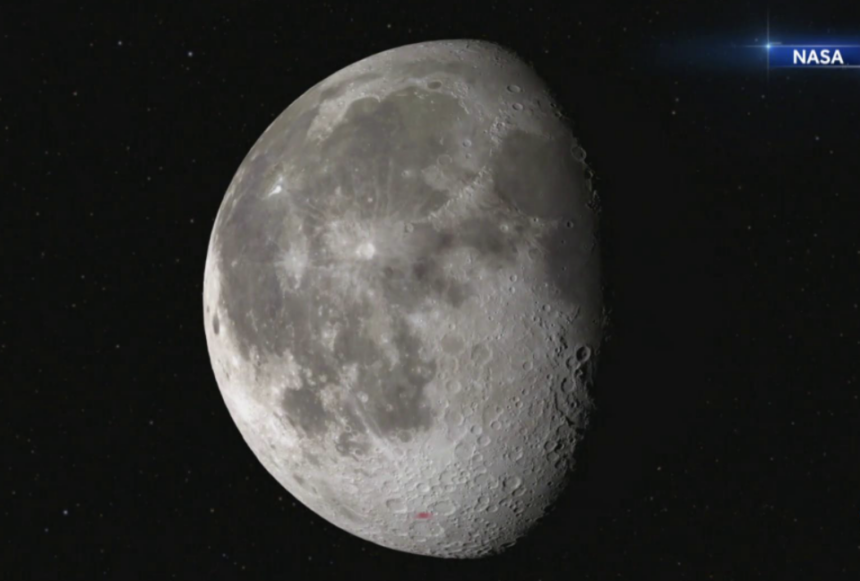Moon has more water than previously thought, scientists say

The new finding suggests that water may be present across more of the lunar surface, beyond just areas that are cold and in shadow.
NASA has discovered water on the sunlit surface of the moon, scientists said Monday, a finding that could help in efforts to establish a permanent human presence on the lunar surface.
NASA's Stratospheric Observatory for Infrared Astronomy, or SOFIA, an airborne observatory housed in a modified Boeing 747 airliner, detected water molecules in Clavius Crater in the moon's southern hemisphere, one of the largest craters visible from Earth.
NEWS: We confirmed water on the sunlit surface of the Moon for the 1st time using @SOFIAtelescope. We don’t know yet if we can use it as a resource, but learning about water on the Moon is key for our #Artemis exploration plans. Join the media telecon at https://t.co/vOGoSHt74c pic.twitter.com/7p2QopMhod
— Jim Bridenstine (@JimBridenstine) October 26, 2020
Water ice has been found on the moon before, in the coldest, darkest regions at the north and south poles. But the new finding suggests that water may be present across more of the lunar surface, beyond just areas that are frigid and permanently in shadow.
"This is exciting because the expectation is that any water present on a sunlit surface of the moon would not survive the lunar day," Paul Hertz, director of the astrophysics division at NASA headquarters in Washington, D.C., said in a news briefing Monday.
The discovery has important implications for human exploration, especially as NASA aims to fly astronauts back to the moon in 2024. Hertz said water on the moon could be used as a resource for astronaut crews or as fuel for expeditions traveling deeper into space, such as future missions to Mars.
Previous observations of the moon's surface found evidence of hydrogen, but scientists weren't able to tell whether the hydrogen atoms indicated the presence of water or hydroxyl, a close chemical relative that is found in drain cleaner.
Using the SOFIA observatory's infrared instruments to study the moon from an altitude of 45,000 feet, researchers were able to detect the distinct chemical fingerprints of water in Clavius Crater.
The amount of water detected was very small, said Casey Honniball, a postdoctoral fellow at NASA's Goddard Space Flight Center in Greenbelt, Maryland, and lead author of a new study about the discovery published Monday in the journal Nature Astronomy. The scientists found about the equivalent of a 12-ounce bottle of water trapped in a cubic meter of soil spread across Clavius Crater.
"To be clear, these are not puddles of water," Honniball said, adding that the molecules are spread so far apart that they don't form ice or liquid water.
Yet even small concentrations of water molecules could have big implications for human spaceflight.
Jacob Bleacher, NASA's chief exploration scientist for the Human Exploration and Operations Mission Directorate, said understanding the origin and state of water on the moon will help the agency plan missions to the lunar surface. If water can be mined on the moon, for example, NASA might be able to free up precious cargo space.
"Water is heavy. Therefore it's expensive to launch from the surface of the Earth," Bleacher said. "It's far easier to travel when you don't have to carry everything with you that you might need for the entire trip."
Still, it's not yet known how accessible water is on the moon, even in sunlit areas. More research is needed, but Honniball said it's possible that the water came from micrometeorites that slammed into the moon. The violent impacts may have encased the water molecules in tiny glass beads, which could explain how they manage to survive in the moon's harsh environment.
"Without a thick atmosphere, water on the sunlit lunar surface should just be lost to space," Honniball said in a statement. "Yet somehow we're seeing it. Something is generating the water, and something must be trapping it there."
The observations of Clavius Crater were made in 2018. The researchers plan to collect more data on future flights of the SOFIA observatory.
NASA also plans to send a golf cart-size rover to the lunar surface in late 2023 to study the origin and distribution of water. The rover, known as the Volatiles Investigating Polar Exploration Rover, is expected to assemble the first maps of water resources on the moon, according to NASA.
